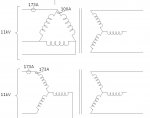- Location
- Wisconsin
- Occupation
- PE (Retired) - Power Systems
3300V is not really very high when it comes to insulation. Think of systems of more than 25kV line to line (about 14.4kv line to ground).I shouldn't have thought it would make a great deal of difference.
I'm currently bidding a 12-pulse variable speed drive. I'm offering two options for the drive transformers - low voltage (690V) and medium voltage (3300V).
Configuration is Dy11d0 in both cases. The transformer prices are within 1% of each other. The MV inverter is more expensive but the additional cost will be offset by the reduced cost of the cabling.

